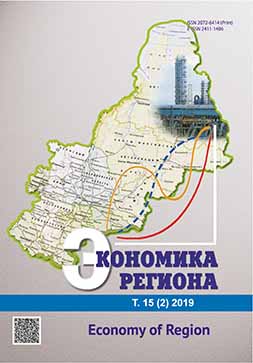МЕТОДИЧЕСКИЙ ИНСТРУМЕНТАРИЙ ДИАГНОСТИКИ ДИВЕРСИФИКАЦИИ СЕЛЬСКОЙ ЭКОНОМИКИ
Methodological Toolkit for Diagnosing the Diversification of Rural Economy
Author(s): Vasilii Georgievich Zakshevskii, Irina Nikolaevna Merenkova, Irina Igorevna Novikova, Elena Sergeevna KusmagambetovaSubject(s): Agriculture, Rural and urban sociology
Published by: Институт экономики Уральского отделения Российской академии наук
Keywords: rural economy diversification; methods for assessing regional diversification; rural resources; rural diversification; rural sectoral structure; diagnostic methodology; additive model;
Summary/Abstract: The article proposes methodological toolkit that takes into account using rural areas’ potential for transition from sectoral to multi-industry economy. The research hypothesis suggests the possibility of creating the system of socio-economic indicators for diagnosing the diversification level in rural economy and providing recommendations for its further development. The research methodology of this problem is highly developed. However, the studies of the opportunities for rural economy diversification are impeded due to the lack of the necessary information and statistical base, which reflect sectoral and resource aspects. Moreover,a unified methodological approach is lacking. We have developed a diagnostic technique of rural economy diversification,which evaluates human, economic and social resources and identifies the priority areas for agricultural and non-agricultural activities and services based on the statistical and expert methods. The proposed technique includes the following stages. The first stage is the selection of indicators characterizing the availability and use of rural areas’ resources. Secondly, we calculate the individual indexes of resource availability. Thirdly, we identify indicators’ weighting factors based on correlation and regression analysis. Fourthly, we measure the levels of the indicators using statistical data. The fifth stage is the expert assessment of the diversification potential directions and choosing the most appropriate one. On the six stage, we define the diversification integrity level. Lastly, we elaborate measures for the rural economy development and forecast their implementation. The conclusions of diversification diagnosis reflect the real situation and allow selecting alternative activities to increase the employment and living standards of rural population. The study’s results can be used by the governing bodies in developing a differentiated policy of rural development.
Journal: Экономика региона
- Issue Year: 15/2019
- Issue No: 2
- Page Range: 520-533
- Page Count: 14
- Language: Russian

